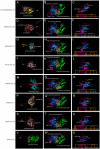Phylogenetic and AlphaFold predicted structure analyses provide insights for A1 aspartic protease family classification in Arabidopsis
- PMID: 36818878
- PMCID: PMC9937552
- DOI: 10.3389/fpls.2023.1072168
Phylogenetic and AlphaFold predicted structure analyses provide insights for A1 aspartic protease family classification in Arabidopsis
Abstract
Aspartic proteases are widely distributed in animals, plants, fungi and other organisms. In land plants, A1 aspartic protease family members have been implicated to play important and varied roles in growth, development and defense. Thus a robust classification of this family is important for understanding their gene function and evolution. However, current A1 family members in Arabidopsis are less well classified and need to be re-evaluated. In this paper, 70 A1 aspartic proteases in Arabidopsis are divided into four groups (group I-IV) based on phylogenetic and gene structure analyses of 1200 A1 aspartic proteases which are obtained from 12 Embryophyta species. Group I-III members are further classified into 2, 4 and 7 subgroups based on the AlphaFold predicted structures. Furthermore, unique insights of A1 aspartic proteases have been unraveled by AlphaFold predicted structures. For example, subgroup II-C members have a unique II-C specific motif in the C-extend domain, and subgroup IV is a Spermatophyta conserved group without canonical DTGS/DSGT active sites. These results prove that AlphaFold combining phylogenetic analysis is a promising solution for complex gene family classification.
Keywords: AlphaFold; Arabidopsis thaliana; aspartic protease; cysteine residues; phylogentic analysis.
Copyright © 2023 Duan, Tang and Yu.
Conflict of interest statement
The authors declare that the research was conducted in the absence of any commercial or financial relationships that could be construed as a potential conflict of interest.
Figures





Similar articles
-
The S8 serine, C1A cysteine and A1 aspartic protease families in Arabidopsis.Phytochemistry. 2004 Jan;65(1):43-58. doi: 10.1016/j.phytochem.2003.09.005. Phytochemistry. 2004. PMID: 14697270
-
The multifaceted roles of plant aspartic proteases.J Exp Bot. 2025 Apr 4:eraf147. doi: 10.1093/jxb/eraf147. Online ahead of print. J Exp Bot. 2025. PMID: 40183522
-
Structure-function characterization of the recombinant aspartic proteinase A1 from Arabidopsis thaliana.Phytochemistry. 2010 Apr;71(5-6):515-23. doi: 10.1016/j.phytochem.2009.12.005. Epub 2010 Jan 14. Phytochemistry. 2010. PMID: 20079503
-
Structure and function of plant aspartic proteinases.Eur J Biochem. 2004 Jun;271(11):2067-75. doi: 10.1111/j.1432-1033.2004.04136.x. Eur J Biochem. 2004. PMID: 15153096 Review.
-
Atypical and nucellin-like aspartic proteases: emerging players in plant developmental processes and stress responses.J Exp Bot. 2019 Apr 12;70(7):2059-2076. doi: 10.1093/jxb/erz034. J Exp Bot. 2019. PMID: 30715463 Review.
Cited by
-
Genome-wide identification and expression patterns of the aspartic protease gene family in Epimedium pubescens.BMC Genomics. 2025 May 2;26(1):436. doi: 10.1186/s12864-025-11617-7. BMC Genomics. 2025. PMID: 40316908 Free PMC article.
-
Evolutionary landscape of plant chalcone isomerase-fold gene families.Front Plant Sci. 2025 Mar 28;16:1559547. doi: 10.3389/fpls.2025.1559547. eCollection 2025. Front Plant Sci. 2025. PMID: 40225028 Free PMC article.
-
Function and Evolution of the Plant MES Family of Methylesterases.Plants (Basel). 2024 Nov 29;13(23):3364. doi: 10.3390/plants13233364. Plants (Basel). 2024. PMID: 39683156 Free PMC article. Review.
-
Review of protein structure-based analyses that illuminate plant stress mechanisms.Comput Struct Biotechnol J. 2025 Jul 13;27:3155-3166. doi: 10.1016/j.csbj.2025.07.021. eCollection 2025. Comput Struct Biotechnol J. 2025. PMID: 40727428 Free PMC article. Review.
-
Identification of plant vacuole proteins by using graph neural network and contact maps.BMC Bioinformatics. 2023 Sep 22;24(1):357. doi: 10.1186/s12859-023-05475-x. BMC Bioinformatics. 2023. PMID: 37740195 Free PMC article.
References
-
- Breitenbach H. H., Wenig M., Wittek F., Jordá L., Maldonado-Alconada A. M., Sarioglu H., et al. . (2014). Contrasting roles of the apoplastic aspartyl protease APOPLASTIC, ENHANCED DISEASE SUSCEPTIBILITY1-DEPENDENT1 and LEGUME LECTIN-LIKE PROTEIN1 in Arabidopsis systemic acquired resistance. Plant Physiol. 165, 791–809. doi: 10.1104/pp.114.239665 - DOI - PMC - PubMed
-
- Cao S., Guo M., Wang C., Xu W., Shi T., Tong G., et al. . (2019). Genome-wide characterization of aspartic protease (AP) gene family in populus trichocarpa and identification of the potential PtAPs involved in wood formation. BMC Plant Biol. 19, 276. doi: 10.1186/s12870-019-1865-0 - DOI - PMC - PubMed
LinkOut - more resources
Full Text Sources

